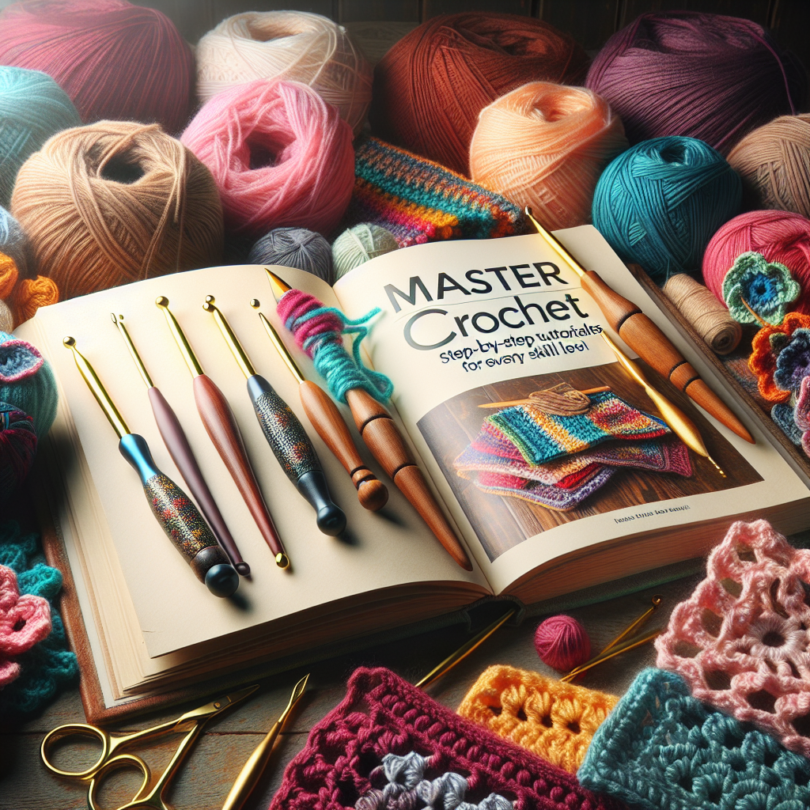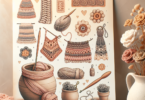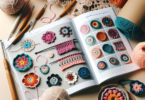Crochet is more than just a hobby; it’s an art form that lets you create beautiful, functional pieces entirely by hand. Whether you’re a total beginner or a seasoned pro looking to polish your skills, this blog post is here to help you master the craft of crochet with step-by-step tutorials that cater to every skill level. So grab your hooks and yarn; it’s time to dive into the wonderful world of crochet!
Why Crochet?
Crocheting not only allows you to create something unique but also offers numerous emotional and psychological benefits. Here are just a few reasons why crocheting is a fantastic pursuit:
- Stress Relief: The repetitive movements of crocheting can be incredibly soothing.
- Creativity: Each pattern can transform into a unique piece of art.
- Community: Join a group or online forum to share tips, patterns, and creations.
- Gift-Making: Handmade gifts hold special meaning and show thoughtfulness.
Getting Started: Crochet Basics
Materials You’ll Need
Before you start on your crochet journey, let’s gather some essential materials:
| Material | Description |
|---|---|
| Yarn | Choose a fiber weight that suits your project (e.g., worsted, bulky). |
| Crochet Hook | Size depends on yarn weight; a 5.0mm (H/8) hook is a great starting point. |
| Scissors | For cutting yarn at the end of your projects. |
| Tapestry Needle | For weaving in ends and finishing touches. |
| Stitch Marker | Helps keep track of rows and stitches. |
Basic Crochet Stitches
Before tackling more complex patterns, it’s crucial to master a few foundational stitches:
- Chain Stitch (ch): The most basic stitch, used to start projects.
- Single Crochet (sc): A simple stitch that forms a tight dense fabric.
- Half Double Crochet (hdc): Slightly taller than a single crochet, adding texture.
- Double Crochet (dc): A taller stitch ideal for lacy patterns.
To practice, try making a swatch that combines these stitches!
Step-by-Step Tutorials
Beginner Tutorial: Simple Crochet Dishcloth
Materials Needed: Worsted weight cotton yarn, 5.0mm crochet hook.
Step 1: Make a Slipknot
- Create a loop with the yarn.
- Pull the working yarn through the loop to form the slipknot.
Step 2: Chain 30
- Use the chain stitch to create a foundation. This will be the width of your dishcloth.
Step 3: Single Crochet Row
- Insert the hook into the second chain from the hook.
- Yarn over and pull up a loop (2 loops on hook).
- Yarn over again and pull through both loops.
- Repeat across the row.
Step 4: Going Up a Row
- Chain 1, turn your work, and continue with rows of single crochet until your dishcloth reaches a square shape.
Step 5: Finishing Touches
- Cut the yarn and weave in the ends using a tapestry needle.
Intermediate Tutorial: Crochet Granny Square
Materials Needed: Yarn of your choice, 5.0mm crochet hook.
Step 1: Start with a Magic Circle
- A magic circle allows for a tight starting point.
Step 2: Create the First Round
- Chain 3 (counts as first double crochet).
- Work 2 double crochets into the circle, chain 2, and repeat for a total of 4 clusters.
- Join with a slip stitch to the top of your initial chain.
Step 3: Begin Rounds Two and Beyond
- Each round will involve chaining 3, working into chain spaces, and joining them until your squares are the desired size.
Advanced Tutorial: Crochet Sweater
Materials Needed: Medium weight yarn, 5.0mm crochet hook, measuring tape.
Step 1: Take Measurements
- Body measurement is important for fitting.
Step 2: Create the Body
- Start with a chain according to your size.
- Work in double crochet until you reach the desired length.
Step 3: Sleeves and Assembly
- Crochet sleeves separately, then sew or slip stitch to the body.
- Finish with a border, and weave in all ends.
FAQs
-
What type of yarn should I use for beginners?
- Start with medium-weight acrylic yarn; it’s affordable and easy to work with.
-
How do I know what size crochet hook to use?
- The yarn label usually recommends a hook size. It’s a good place to start.
-
What’s the difference between crocheting and knitting?
- Crocheting uses a single hook, while knitting uses two needles. They create different textures.
-
Can I crochet with any type of yarn?
- Yes, but keep in mind that different yarns yield different results. Choose the best type for your project.
-
How can I fix my mistakes in crochet?
- The best way is to "frog" your work—unravel the stitches back to where you made the mistake.
-
Are there any good resources for learning more crochet techniques?
- Absolutely! YouTube has amazing tutorials, and books from experts are widely available.
-
How can I improve my crochet skills?
- Practice regularly, try new patterns, and don’t hesitate to ask for help from experienced crocheters.
-
What projects are best for beginners?
- Start with simple items like dishcloths, scarves, or simple blankets.
-
Can I crochet with thread instead of yarn?
- Yes, using crochet thread results in delicate lace projects but requires a smaller hook.
- How do I care for my crochet items?
- Hand wash your creations and lay them flat to dry whenever possible.
Conclusion
Mastering crochet is an easy yet rewarding journey. With each loop you create, you open doors to creativity, relaxation, and perhaps even a lasting passion. Whether you’re just starting or looking to take your skills to the next level, these step-by-step tutorials guide you with care and clarity. So, grab your yarn and hook—let’s crochet something beautiful together! Happy stitching!



Leave a Comment